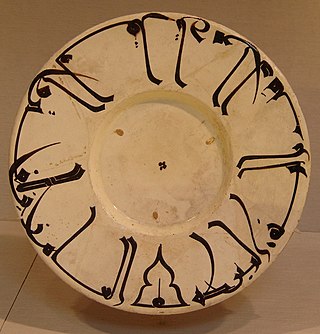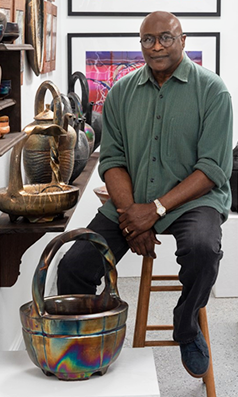External links
| International | |
|---|---|
| National | |
| Academics | |
| Artists | |
| | This article about a British sculptor is a stub. You can help Wikipedia by expanding it. |
Peter Hayes (born 1946) [1] is a contemporary sculptor now based in Bath, England, [1] whose work is displayed in public locations including the UK, US, Canada and Belgium.
Hayes was born in Birmingham, England, where, aged 12, he was selected to attend the Moseley School of Art. In 1961 he left to study at the Birmingham College of Art before travelling extensively in Africa. Over the course of several years, he worked as a ceramic artist with tribes and village potters who inspired him with the exquisite work they produced using very limited technology and tools. Moving on to India, Nepal, Japan, Korea and New Mexico, he found similar skills and adopted the techniques he learned. In 1982, Hayes came home and built a studio in a disused toll house on Cleveland Bridge, Bath. His work now builds on the techniques and methods he learned during his travels to create ceramic art that is often inspired by memories of landscapes he has seen.
The distinctive appearance of Peter Hayes’ ceramic works is partly a result of techniques such as Raku firing he employs but also reflects his habit of submerging pieces in the flowing river beside his studio, or sending them to Cornwall to be washed in the sea, for months at a time. The water washes minerals such as copper and metal oxides into the basic white clay with which Hayes works, creating a characteristic green-blue "blush" in his sculptures along with random elements that make every piece unique. The effect is to create objects that many feel look ancient and perhaps even a little alien. Hayes' work is generally finished by waxing and polishing.

Earthenware is glazed or unglazed nonvitreous pottery that has normally been fired below 1,200 °C (2,190 °F). Basic earthenware, often called terracotta, absorbs liquids such as water. However, earthenware can be made impervious to liquids by coating it with a ceramic glaze, and is used for the great majority of modern domestic earthenware. The main other important types of pottery are porcelain, bone china, and stoneware, all fired at high enough temperatures to vitrify. End applications include tableware, decorative ware such as figurines.

Shōji Hamada was a Japanese potter. He had a significant influence on studio pottery of the twentieth century, and a major figure of the mingei (folk-art) movement, establishing the town of Mashiko as a world-renowned pottery centre. In 1955 he was designated a "Living National Treasure".

Studio pottery is pottery made by professional and amateur artists or artisans working alone or in small groups, making unique items or short runs. Typically, all stages of manufacture are carried out by the artists themselves. Studio pottery includes functional wares such as tableware and cookware, and non-functional wares such as sculpture, with vases and bowls covering the middle ground, often being used only for display. Studio potters can be referred to as ceramic artists, ceramists, ceramicists or as an artist who uses clay as a medium.

Jun Kaneko is a Japanese-born American ceramic artist known for creating large scale ceramic sculpture. Based out of a studio warehouse in Omaha, Nebraska, Kaneko primarily works in clay to explore the effects of repeated abstract surface motifs by using ceramic glaze.

Maria Montoya Martinez was a Native American artist who created internationally known pottery. Martinez, her husband Julian, and other family members, including her son Popovi Da, examined traditional Pueblo pottery styles and techniques to create pieces which reflect the Pueblo people's legacy of fine artwork and crafts. The works of Maria Martinez, and especially her black ware pottery, survive in many museums, including the Smithsonian, the Metropolitan Museum of Art, the Denver Art Museum, and more. The Penn Museum in Philadelphia holds eight vessels – three plates and five jars – signed either "Marie" or "Marie & Julian".
Toshiko Takaezu was an American ceramic artist, painter, sculptor, and educator who was known for her rounded, closed forms that viewed ceramics as a fine art and more than a functional vessel. She is of Japanese descent and from Pepeeko, Hawaii.

Edwin Scheier was an American artist, best known for his ceramic works with his wife, Mary Scheier.
John Mason was an American artist who did experimental work with ceramics. Mason's work focused on exploring the physical properties of clay and its "extreme plasticity". One of a group of artists who had studied under the pioneering ceramicist Peter Voulkos, he created wall reliefs and expressionistic sculptures, often on a monumental scale.
Regis Brodie is a tenured Professor of Art at the Department of Art and Art History at Skidmore College in Saratoga Springs, NY and a potter. Since 1972, he has been serving as the Director of the Summer Six Art Program at Skidmore College. He also wrote a book called The Energy Efficient Potter which was published by Watson-Guptill Publications in 1982. He started the Brodie Company in 1999 in the interest of developing tools which would aid the potter at the potter's wheel.
Steven Kemenyffy is an American ceramic artist living and working in Pennsylvania. He is most recognized for his contributions to the development of the American ceramic raku tradition. Beginning in 1969, he served as a Professor of Ceramic Art at Edinboro University of Pennsylvania. He retired from teaching after forty years, but continues to produce artwork at his home studio in McKean, Pennsylvania.

James C. Watkins was born in Louisville, Kentucky, in 1951 and raised in a farming family in Athens, Alabama. He is a ceramic artist living in Lubbock, Texas who has worked with clay for over 40 years. He is known for his large scale double-walled ceramic vessels and laser cut porcelain substrate tiles. He is recognized for his textured surfaces, created by using alternative firing techniques. His porcelain substrate tiles are fumedArchived 2014-09-07 at the Wayback Machine with stannous chloride and multi-fired using ferric chloride, gold and platinum luster to achieve colorful surfaces.
Jack Doherty is a Northern Irish studio potter and author. He is perhaps best known for his vessels made of soda-fired porcelain. He has been featured in a number of books, and his work has been exhibited widely in both Europe and North America. Articles of his have appeared in various pottery journals and he has been Chair of the Craft Potters Association.

Susan Harnly Peterson was an American artist, ceramics teacher, author and professor.

Ceramic art is art made from ceramic materials, including clay. It may take forms including artistic pottery, including tableware, tiles, figurines and other sculpture. As one of the plastic arts, ceramic art is one of the visual arts. While some ceramics are considered fine art, such as pottery or sculpture, most are considered to be decorative, industrial or applied art objects. Ceramics may also be considered artefacts in archaeology. Ceramic art can be made by one person or by a group of people. In a pottery or ceramic factory, a group of people design, manufacture and decorate the art ware. Products from a pottery are sometimes referred to as "art pottery". In a one-person pottery studio, ceramists or potters produce studio pottery.
Susan Hale Kemenyffy is an American artist who works primarily in drawing and print media. She is known for the innovative raku art she created in collaboration with her husband Steven Kemenyffy.
Alice Williams Cling is a Native American ceramist and potter known for creating beautiful and innovative pottery that has a distinctive rich reds, purples, browns and blacks that have a polished and shiny exteriors, revolutionizing the functional to works of art. Critics have argued that she is the most important Navajo potter of the last 25 years.

Donald Lester Reitz was an American ceramic artist, recognized for inspiring a reemergence of salt glaze pottery in United States. He was a teacher of ceramic art at the University of Wisconsin–Madison from 1962 until 1988. During this period, he adapted the pottery firing technique developed in the Middle Ages, which involved pouring salt into the pottery kiln during the firing stage. The method was taught in European ceramic art schools, but largely unknown in United States studio pottery.
Karl Martz was an American studio potter, ceramic artist, and teacher whose work achieved national and international recognition.
Susan Folwell is a Native American artist from Santa Clara Pueblo, New Mexico, known for her work in the ceramic industry. Her work ties in Native designs and history and has been used by Folwell to demonstrate her viewpoints on society and politics. Folwell has been described by the Heard Museum as an "innovator in Pueblo pottery".

Black-on-black ware is a 20th- and 21st-century pottery tradition developed by Puebloan Native American ceramic artists in Northern New Mexico. Traditional reduction-fired blackware has been made for centuries by Pueblo artists and other artists around the world. Pueblo black-on-black ware of the past century is produced with a smooth surface, with the designs applied through selective burnishing or the application of refractory slip. Another style involves carving or incising designs and selectively polishing the raised areas. For generations several families from Kha'po Owingeh and P'ohwhóge Owingeh pueblos have been making black-on-black ware with the techniques passed down from matriarch potters. Artists from other pueblos have also produced black-on-black ware. Several contemporary artists have created works honoring the pottery of their ancestors.